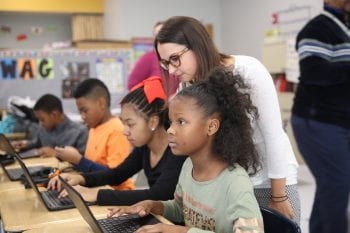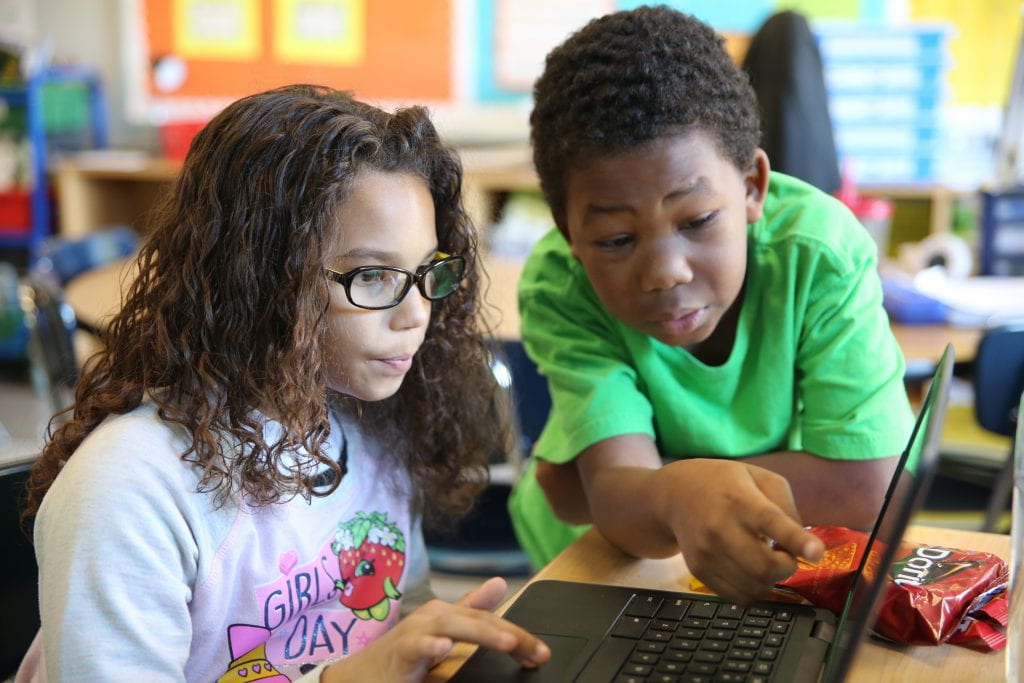“I made it move,” an ecstatic Jalen Royston said as he bolted up from his seat, pumping his fists in the air.
He’d inputted the correct code to make clouds on his computer screen move to the left.
Sporting a “Hello, I’m Awesome” T-shirt, Jalen, a fifth-grader at Barbara C. Jordan Elementary School in The School District of University City, was taking part in an Hour of Code challenge designed by the Institute for School Partnership at Washington University in St. Louis. Using a computer program called Scratch, Jalen used code to simulate a thunderstorm.
This is the first year, the ISP has taken part in the Hour of Code challenge, a one-hour introduction to computer science. Launched in 2013 by Code.org, the initiative is designed to demystify code and takes place during Computer Science Education week. The challenge has become a global movement.
“It was amazing,” said fourth-grader Ania Hargrove of her coding experience.
Fifth-graders Victor Escorcia and Ryan Anderson call themselves the “mistake crew.” They say it means they make mistakes and learn from them – a perfect motto for the pair who are eyeing STEM careers. They want to be programmers when they grow up.
Zig-zagging around one of the classroom’s helping students was ISP K-8 curriculum coordinator Melanie Turnage. She was impressed with the student’s abilities. Usually a teacher gauges if a lesson is appropriate by a student’s age. But in coding, experience matters more. It’s possible for a second-grader to be more advanced than a middle school student.

“Working with one of the fifth-graders today I watched over his shoulder as he created a Sprite (image or animated graphic) and added it to the coding sequence before even viewing our tutorial,” Turnage said. “He already had some ideas about what to add and knew how to add it. I definitely could tell that he ‘got it’ and maybe surpassed the learning goals for the day.”
The class of third-grade teacher Alisha Ashford hosted one of the coding activities. Ashford knows first-hand the importance of coding and computer science. Before entering the classroom, she was a programmer in her previous career.
“It’s the future. It’s what they are going to be doing,” she said. “Why not teach them another language that is going to be prominent in their world, so that they are bilingual in computers. Plus, a lot of careers use computer science. It’s not a skill that’s going to be obsolete.”
ISP instructional specialists Jaime Gilligan and Victoria Engel designed the challenge they called Stormy Science as an opportunity for students to explore the integration of computer science and science. Their goal was threefold. They wanted it to be fun, accessible to students with limited coding experience, and require little teacher support.
“Watching the students complete the challenge was such a rewarding experience,” Gilligan said. “The level of student engagement was unbelievable and the collaboration I witnessed was exactly the type of learning I hope to see in every computer science classroom.”
Engel said the students were inspired by the Hour of Code activity. They learned programming can create things that can be fun or functional, or both. Many shared with her visions of creating a video game or interactive car or picture.
Gilligan and Engel even enlisted some famous St. Louis faces to help in their effort. KSDK Channel 5 chief meteorologist Craig Moeller and meteorologist Jessica Quick graciously agreed to star in a video introducing the challenge. They both explained how computers have drastically changed weather forecasting for the better.
While three classrooms participated in the Hour of Code activity at Barbara C. Jordan, the website was shared online and is available for use to any class. Here’s a link to the website https://sites.google.com/view/mysci-hour-of-code.
